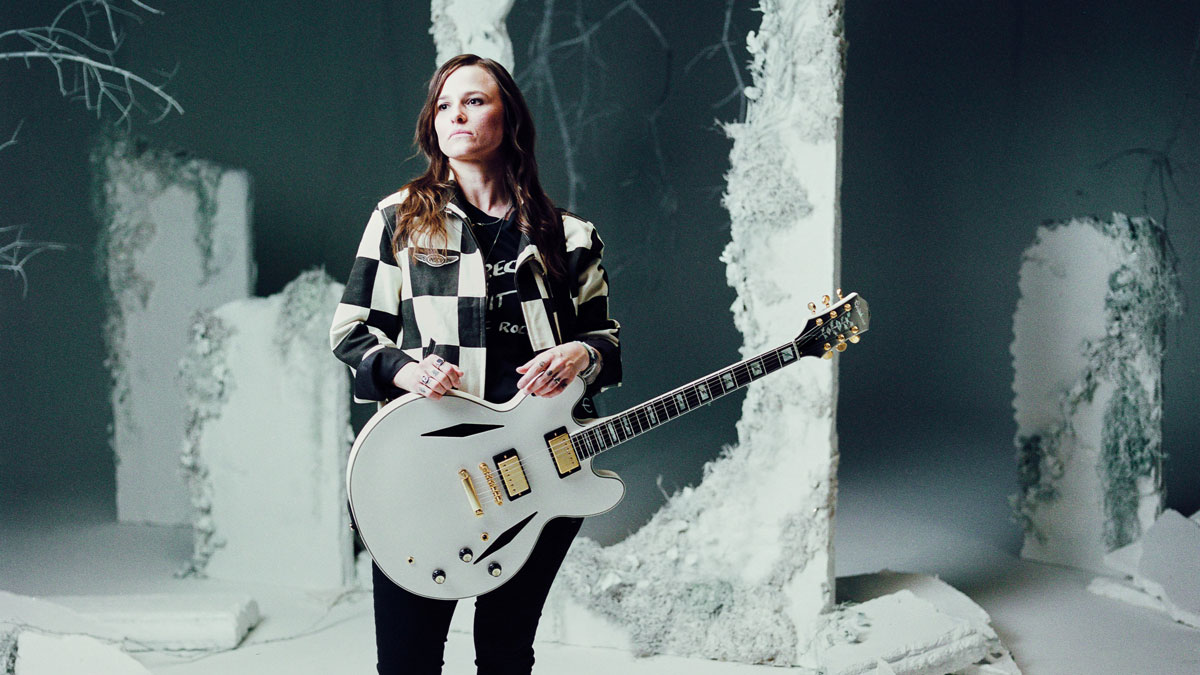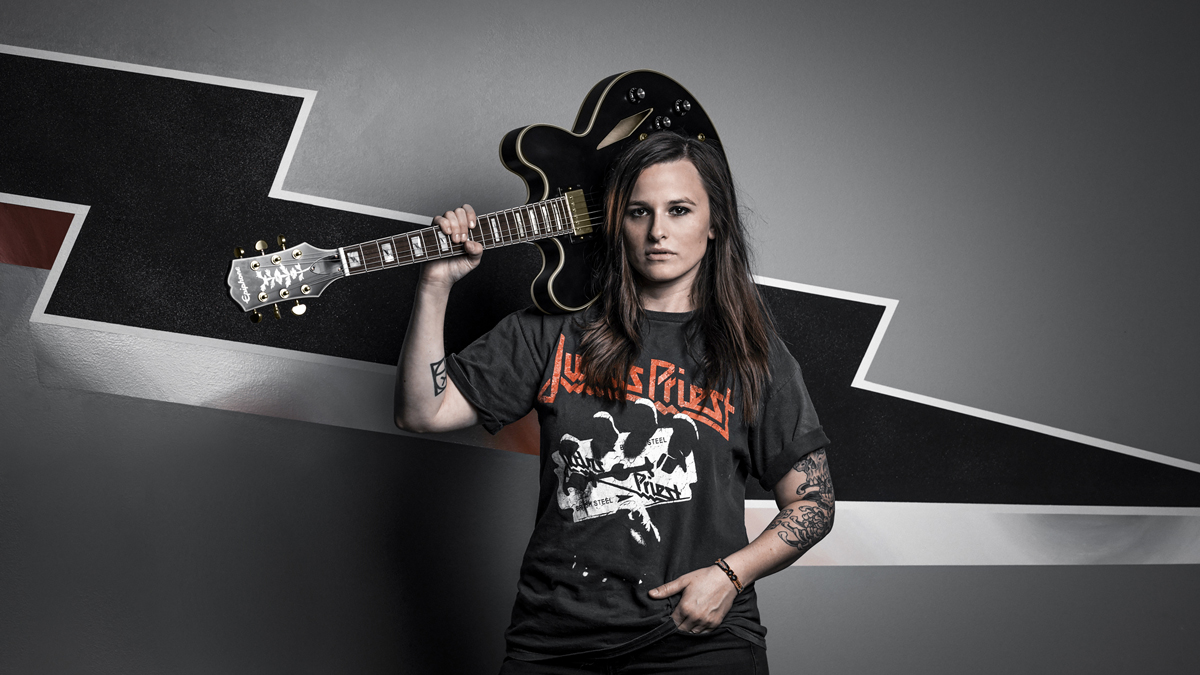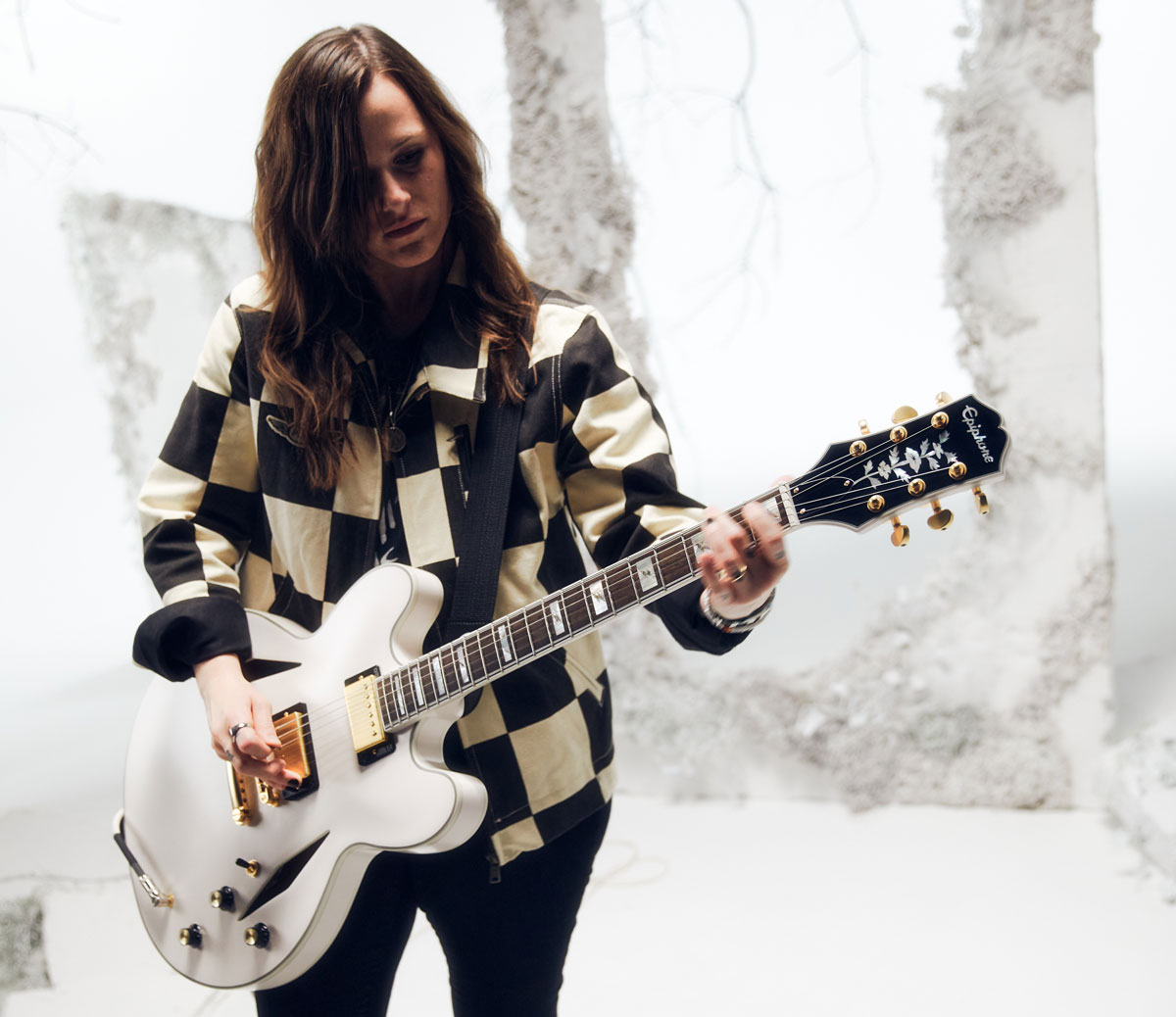“Tone is so important to me. Whenever I go to a show and there are good guitar sounds, I soak it in”: For Emily Wolfe, the tone is as important as the hooks – and her Epiphone signature model is key to her explosive sound
Wolfe’s evocative music draws upon both Motown and Zeppelin but has a taut and soulful contemporary edge. We joined the Texan on tour to learn all about it…

With Emily Wolfe and Epiphone teaming up again for a new-look take on her Sheraton signature guitar – the White Wolfe – we take the opportunity to check in with one of guitar’s great mavens of tone.
Wolfe is a connoisseur, with a sound that takes the scenic route through rock ’n’ roll history and remixes and refreshes it anew for the 21st-century, leaning into the bountiful choice that guitar players have when choosing stompboxes, and using a well-stocked ‘board to shape her electric guitar tone – including a gain stage that features the full trifecta of fuzz, boost and overdrive pedals.
Your music skillfully interweaves strong guitar hooks with emotive vocals. How did you develop your sound?
“It’s been [through] a lot of touring, and trial and error on the road. For instance, this one time I was at the merch table after my show, and this guy said, ‘It’s so crazy how you harmonise your vocals with your guitar.’ And I was like, ‘I did that? I didn’t even remember that.’ From that point forward, I thought, ‘Well, maybe I could just purposefully do that?’ These bits of information I get, I carry with me.
“For the most part, I came from the foundation of Motown songwriting and classic rock guitar playing, because my mom loved Motown and Stax, and my dad would play Zeppelin and Creedence. When I got to college, I found my own way musically. I got into blues and Queens of the Stone Age and ‘interesting rock,’ and that all came together.
“My mission with my career and style is to make the juxtaposition of art rock and singer-songwriter floaty vocals make sense. So that’s what I wanted to do. I love writing hooks and making sure things are ‘sticky’ with the listener. I’ve also had this overarching mission to make something no one’s heard before. That’s the goal.”
You have a new Epiphone signature model out. Tell us about it…
Get The Pick Newsletter
All the latest guitar news, interviews, lessons, reviews, deals and more, direct to your inbox!
“I played a regular Sheraton for years. I love B.B. King and there’s just something about a semi-hollowbody that I love. It’s heavier [sonically] – it feels like something to tackle and I like that when I’m playing live. So I played that Sheraton forever, but then I started working with Epiphone and thankfully they wanted to do a signature model.
“The first version, the Stealth model, was black and came out before this White Wolfe, but it’s essentially my take on a Sheraton. The headstock is smaller and there’s lightning-bolt inlays, a black matte finish and aged gold hardware. And it’s the perfect guitar for me – it’s simpler than the Sheraton, because it doesn’t have a four-knob control layout. And it just felt like something I could throw around and not damage, because I have done that [laughs], and it stayed intact.

“So this time around, Epiphone wanted to do another one and I decided to go with the aged bone-white finish. It’s essentially the same guitar, but just a different colour. I use both the Stealth and the White Wolfe guitars all over my new record that’s coming out in the fall.
“The guitar just sounds great live, too: the pickups are lower output, so it’s really good with fuzz, which I love. So, yeah, that’s kind of the story about the guitar and it’s just been such a milestone in my career. It’s just been really cool and I’m super-grateful.”
You get really chunky, expressive guitar tones from your Sheraton – what do you plug it into?
“I like to get my tone from my pedals. It’s so interesting talking to other guitar players – some of them love looking at my pedalboard, and some say: ‘That’s insane. Why do you have such a big pedalboard?’ I’m like, ‘Because I love pedals…’
“The gain stage is fuzz, overdrive and then a clean kind of boost. So that’s the core sounds of the board, and there’s also delay, reverb tremolo and chorus, and I also have an octave-down pedal that I like to use. There’s also a [pedal] switcher that I love – the RJM Mastermind PBC/10.
“It’s big, but it’s kind of changed everything when it comes to performing because it gives me seven [pre-selected groups of pedals that can be engaged with one footswitch]. It was hard, without that thing, to sing in tune, remember lyrics, perform and capture an audience and also step on the pedals. Getting there quicker changed my life.”

“For fuzz, I use a discontinued EarthQuaker Devices pedal called a Dirt Transmitter. What I love about it is it’s kind of dark. Bright, high frequencies kill me; they rattle my brain – and fuzz that’s spitty and trebly coming out of monitors in a small club is awful for the audience. So I prefer to start dark, and then brighten it up with EQ.
“And then right before the Dirt Transmitter is my favourite effect, which is called the Tentacle. There are no knobs: it’s just a footswitch and it’s basically the octave circuit of an Octo-fuzz but without the fuzz. So it sounds awful by itself, like so bad. But if you put it before a fuzz, it brings out this really insane high-octave that I’ve never heard before. It’s a really interesting sound.
Bright, high frequencies kill me; they rattle my brain – and fuzz that’s spitty and trebly coming out of monitors in a small club is awful for the audience
“Then, for overdrive, I haven’t ever been able to get away from the Fulltone OCD – I love it; it’s how a drive should sound, to me. That said, I put an EQ pedal right after it to take out that insane low-end it has and pump the mids… and it’s perfect.
“There’s also an Origin Effects Cali 76 compressor at the top and that’s about it. I plug into a Fender DeVille 410, Because I like amps that [are pretty clean] because, as I said, I like to get my sound from my pedals.
“Tone is so important to me. And sometimes people think it’s silly, but I know that whenever I go to a show and there’s good guitar sounds, I soak it in. I want to keep people at my show, so I have to make sure the tones sit in people’s ears just right.”
- For more information on the “White Wolfe” Sheraton, head to Epiphone.
Jamie Dickson is Editor-in-Chief of Guitarist magazine, Britain's best-selling and longest-running monthly for guitar players. He started his career at the Daily Telegraph in London, where his first assignment was interviewing blue-eyed soul legend Robert Palmer, going on to become a full-time author on music, writing for benchmark references such as 1001 Albums You Must Hear Before You Die and Dorling Kindersley's How To Play Guitar Step By Step. He joined Guitarist in 2011 and since then it has been his privilege to interview everyone from B.B. King to St. Vincent for Guitarist's readers, while sharing insights into scores of historic guitars, from Rory Gallagher's '61 Strat to the first Martin D-28 ever made.
“This would make for the perfect first guitar for any style of player whether they’re trying to imitate John Mayer or John Petrucci”: Mooer MSC10 Pro review
“The most in-demand mods straight from the factory”: Fender’s elevated Player II Modified line brings the firm’s most sought-after guitar upgrades to the masses








![John Mayer and Bob Weir [left] of Dead & Company photographed against a grey background. Mayer wears a blue overshirt and has his signature Silver Sky on his shoulder. Weir wears grey and a bolo tie.](https://cdn.mos.cms.futurecdn.net/C6niSAybzVCHoYcpJ8ZZgE.jpg)

![A black-and-white action shot of Sergeant Thunderhoof perform live: [from left] Mark Sayer, Dan Flitcroft, Jim Camp and Josh Gallop](https://cdn.mos.cms.futurecdn.net/am3UhJbsxAE239XRRZ8zC8.jpg)
